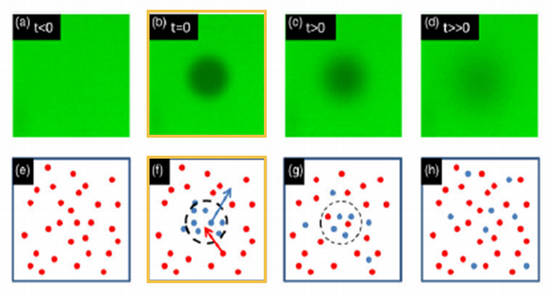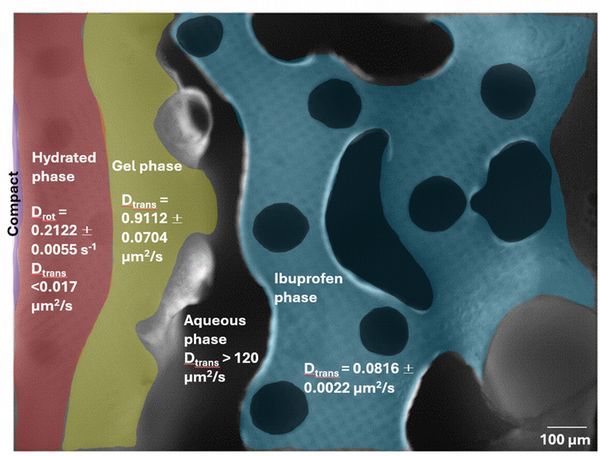Diffusion mapping with patterned photobleaching and Fourier analysis
Methods for characterizing phase stability and molecular mobility within pharmaceutical formulations has emerged as useful tools to provide insight into mechanisms, contributing to losses in bioavailability. Other methods, such as THz spectroscopy and NMR, have been employed to probe fast rotational or local motion. However, these methods do not provide spatially resolved measures of molecular mobility.
Fluorescence recovery after photobleaching (FRAP) offers a simple way to analyze local diffusion over short (<500 nm) distances. Commonly use in biology and materials science, point-bleach FRAP involves photobleaching a focused region and tracking fluorescence reocvery as molecules diffuse. Recovery timescales provide insight into diffusion models.

Figure 1: Theory behind point bleach FRAP. Red dots represent unbleached fluorophores (e). A targeted spot is photobleached, with the affected fluorophores shown in blue (f). Over time, fluorescence recovers as photobleached fluorophores diffuse out of the region while unbleached fluorophores diffuse in (g, h).
However, point-bleach FRAP has limitations: (a) it only captures mobility near the bleach spot, which may not be representative, (b) most of the field of view does not contribute to mobility data, and (c) multi-photon excitation, useful in turbid media, causes local heating in conventional FRAP.
To overcome these challenges, we developed a method using photobleaching in the spatial Fourier transform (FT) domain instead of real space. By rapidly scanning the beam along one axis and modifying the slow-scan pattern, we impose a periodic "comb bleach" pattern. This generates distinct spatial harmonics, allowing us to probe diffusion over multiple well-defined length scales, enabling precise differentiation between normal and anomalous diffusion.
Recent advancements have incorporated a diffractive optical element (DOE) into the FT-FRAP beam path, enabling periodic patterned photobleaching with a dot array. Fluorescence recovery is analyzed in the spatial Fourier transform (FT) domain, generating diffusion recovery curves over well-defined distances. Unlike previous comb bleaching methods, diffusion recovery distances in the spatial FT domain are directly linked to the 2D (h,k) Miller indices of the corresponding lattice lines. The dot array improves the distribution of photobleaching power across the entire field of view (FOV), enhancing the signal-to-noise ratio. Figure 2 illustrates the dot array photobleaching pattern, its corresponding Fourier transform, and representative diffusion recovery curves extracted from various Miller index components.


Figure 3: Molecular diffusion coefficients analyzed using FT-FRAP of 15% Ibuprofen in PVPVA with rhodamine 6G sitting in pH 2.5 buffer (unpublished figure)
FT-FRAP applications, and current research, include pharmaceutical stability studies conducted using a custom-built stability chamber at the Jonathan Amy Facility for Chemical Instrumentation (JAFCI), as well as investigations of phase separation in amorphous solid dispersions (ASDs) within compact formulations immersed in bulk water (Figure 3)
See our most recent publications below:
- FT-FRAP Theory: Harmon, D. M.; Cao, Z.; Sherman, A. M.; Takanti, N.; Murati, K.; Wimsatt, M. M.; Cousineau, M. L.; Hwang, Y.; Taylor, L. S.; Simpson, G. J. Diffusion Mapping with Diffractive Optical Elements for Periodically Patterned Photobleaching. Anal Chem 2024, ASAP. https://doi.org/10.1021/ACS.ANALCHEM.3C05728.
- FT-FRAP Theory: Cao, Z.; M. Harmon, D.; Yang, R.; Razumtcev, A.; Li, M.; S. Carlsen, M.; C. Geiger, A.; Zemlyanov, D.; M. Sherman, A.; Takanti, N.; Rong, J.; Hwang, Y.; S. Taylor, L.; J. Simpson, G. Periodic Photobleaching with Structured Illumination for Diffusion Imaging. Anal Chem 2023, 95 (4), 2192–2202. https://doi.org/10.1021/acs.analchem.2c02950.
- Image reconstruction methods for FT-FRAP: Rong, J.; Harmon, D.; Cao, Z.; Song, Y.; Zeng, L.; Simpson, G. J. Diffusion and Exchange Kinetics of Microparticle Formulations by Spatial Fourier Transform Fluorescence Recovery after Photobleaching with Patterned Illumination. Pharmaceutics 2024, 21 (11), 5539–5550. https://doi.org/10.1021/acs.molpharmaceut.4c00508.
- Pharmaceutical stability chamber: Sarkar, S.; Song, Z.; Griffin, S.R.; Takanti, N.; Vogt, A.; Ruggles, A.; Danzer, G. D.; Simpson, G.J. “In situ Crystal Growth Rate Distributions of Active Pharmaceutical Ingredients” Mol Pharm.2020, 17, 769-76.